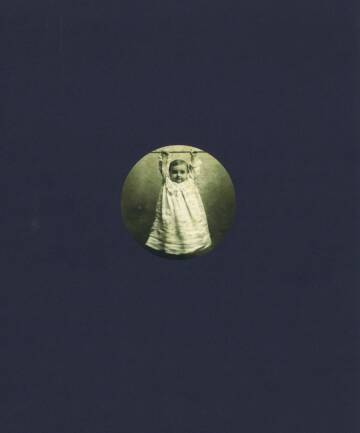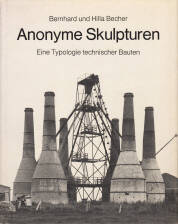The Hidden Mother
by Linda Fregni Nagler
Photographs: Linda Fregni Nagler
Text: Massimiliano Gioni, Geoffrey Batchen and a conversation between Francesco Zanot and Linda Fregni Nagler
Publisher: MACK Books Co-published with the Nouveau Musée National de Monaco
432 pages
Pictures: 1002 colour plates
Year: 2013
ISBN: 978-1-907946-53-0
Comments: 23.8 cm x 28.6 cm, softcover with a die cut dustjacket
In the vein of Francis Alÿs’s Fabiola and Andy Warhol’s Time Capsules, Linda Fregni Nagler has collected seemingly nondescript images and accumulated a meaningful archive, thereby giving them a renewed purpose and intensity.
The Hidden Mother is comprised of 1,002 photographs (from daguerreotypes and tintypes to cartes de visite and cabinet cards), all examples of a now redundant practice: to cloak or hide a parent within the background of a child’s portrait, a common procedure from the advent of photography up until the 1920s, when exposure times were relative slow, and a hidden parent was required to hold the child still.
These hidden mothers can be discerned in the background of every one of these portraits – looming behind their children, swaddled in blankets, carpets and brocades as they support their progeny as the central subject. The iterations vary, and in some instances the hidden mother is revealed as a single hand, while in others the child is seated on a shrouded figure, or the parent is quite literally hiding – ensuring that the child’s identity is transposed over their own.
The images hold a certain degree of comedy – albeit unintentional – because the viewer is asked to suspend their disbelief, to ‘not see’ the hidden figure. Some contemporary onlookers would have simply not seen the portrait’s hidden mother, indicative of the cultural nature of the act of seeing. For other viewers, the hidden figure was an essential part of the picture: high infant mortality rates meant that posthumous portraits were the norm, and thus the hidden mother would signify to the viewer that this child was alive.
Creating and defining a sub-genre of photography, Fregni Nagler has accumulated images that repeat a particular gesture – the negation of the parent in the interest of the legibility of the child. The many themes bubbling under the surface of her collection are unified by the singular principle of effacement – as if this gesture speaks of the nature of parenthood itself, or of women’s place in a patriarchal society, where she is figured without an identity of her own.
The collection also confronts the inevitable self-effacing nature of the photographer and the collector. The artist herself seems to hover over these images like a mother – conserving and safeguarding these photographs; as collector, presenter and curator of the collection, Fregni Nagler herself becomes another hidden mother.
more books tagged »portrait« | >> see all
-
END. (signed - last copy)
by Eamonn Doyle
sold out -
Etan & Me (signed)
by Viviane Sassen
sold out -
Twenty-one Years in One Second (book + print)
by Erik Hinz
Euro 370 -
Imperial Courts (signed - last copy)
by Dana Lixenberg
sold out -
On Daily Life
by Shiho Yanagimoto
sold out -
LEXICON (last copies)
by Viviane Sassen
sold out
more books tagged »archive« | >> see all
-
Cucurrucucú (signed)
by Cristina de Middel
Euro 49 24.50 -
Mrs. Merryman's Collection - used copy
by Anne Sophie Merryman
Euro 95 57.00 -
Big Zep
by various photographers
Euro 31.90 19.14 -
Lisboa, Cidade Triste e Alegre
by Costa Martins & Victor Palla
sold out -
Jan Mayen (signed)
by Cristina de Middel
sold out -
ANATOPÉES (signed)
by Arnaud Lesage
sold out
more books tagged »children« | >> see all
-
Reading Raymond Carver (last copy)
by Mary Frey
sold out -
THIS IS WHAT HATRED DID
by Cristina de Middel
Euro 66 -
This World of Dew (signed)
by Aini Hasina Bano, Chandan Gomes
sold out -
THIS IS WHAT HATRED DID (signed - last copy)
by Cristina de Middel
Euro 135 -
THIS IS WHAT HATRED DID (review copy)
by Cristina de Middel
sold out -
Summer of the Fawn (last copy of book + signed print)
by Alain Laboile
Euro 450
more books tagged »Swedish« | >> see all
-
Swedish red
by Joakim Eneroth
Euro 28.80 -
Bristningar
by Katinka Goldberg
Euro 44 -
Sleeping State of Being (Creatures of Night and Day)
by Sara Skorgan Teigen
sold out -
Another Language
by Mårten Lange
sold out -
Hanezawa Garden
by Anders Edström
sold out -
How Much Silence Can You Take? (signed)
by Marie Sjøvold
Euro 36
Random selection from the Virtual bookshelf josefchladek.com
The Hidden Mother
by Linda Fregni Nagler
Photographs: Linda Fregni Nagler
Text: Massimiliano Gioni, Geoffrey Batchen and a conversation between Francesco Zanot and Linda Fregni Nagler
Publisher: MACK Books Co-published with the Nouveau Musée National de Monaco
432 pages
Pictures: 1002 colour plates
Year: 2013
ISBN: 978-1-907946-53-0
Comments: 23.8 cm x 28.6 cm, softcover with a die cut dustjacket
In the vein of Francis Alÿs’s Fabiola and Andy Warhol’s Time Capsules, Linda Fregni Nagler has collected seemingly nondescript images and accumulated a meaningful archive, thereby giving them a renewed purpose and intensity.
The Hidden Mother is comprised of 1,002 photographs (from daguerreotypes and tintypes to cartes de visite and cabinet cards), all examples of a now redundant practice: to cloak or hide a parent within the background of a child’s portrait, a common procedure from the advent of photography up until the 1920s, when exposure times were relative slow, and a hidden parent was required to hold the child still.
These hidden mothers can be discerned in the background of every one of these portraits – looming behind their children, swaddled in blankets, carpets and brocades as they support their progeny as the central subject. The iterations vary, and in some instances the hidden mother is revealed as a single hand, while in others the child is seated on a shrouded figure, or the parent is quite literally hiding – ensuring that the child’s identity is transposed over their own.
The images hold a certain degree of comedy – albeit unintentional – because the viewer is asked to suspend their disbelief, to ‘not see’ the hidden figure. Some contemporary onlookers would have simply not seen the portrait’s hidden mother, indicative of the cultural nature of the act of seeing. For other viewers, the hidden figure was an essential part of the picture: high infant mortality rates meant that posthumous portraits were the norm, and thus the hidden mother would signify to the viewer that this child was alive.
Creating and defining a sub-genre of photography, Fregni Nagler has accumulated images that repeat a particular gesture – the negation of the parent in the interest of the legibility of the child. The many themes bubbling under the surface of her collection are unified by the singular principle of effacement – as if this gesture speaks of the nature of parenthood itself, or of women’s place in a patriarchal society, where she is figured without an identity of her own.
The collection also confronts the inevitable self-effacing nature of the photographer and the collector. The artist herself seems to hover over these images like a mother – conserving and safeguarding these photographs; as collector, presenter and curator of the collection, Fregni Nagler herself becomes another hidden mother.
more books tagged »portrait« | >> see all
-
END. (signed - last copy)
by Eamonn Doyle
sold out -
Etan & Me (signed)
by Viviane Sassen
sold out -
Twenty-one Years in One Second (book + print)
by Erik Hinz
Euro 370 -
Imperial Courts (signed - last copy)
by Dana Lixenberg
sold out -
On Daily Life
by Shiho Yanagimoto
sold out -
LEXICON (last copies)
by Viviane Sassen
sold out
more books tagged »archive« | >> see all
-
Cucurrucucú (signed)
by Cristina de Middel
Euro 49 24.50 -
Mrs. Merryman's Collection - used copy
by Anne Sophie Merryman
Euro 95 57.00 -
Big Zep
by various photographers
Euro 31.90 19.14 -
Lisboa, Cidade Triste e Alegre
by Costa Martins & Victor Palla
sold out -
Jan Mayen (signed)
by Cristina de Middel
sold out -
ANATOPÉES (signed)
by Arnaud Lesage
sold out
more books tagged »children« | >> see all
-
Reading Raymond Carver (last copy)
by Mary Frey
sold out -
THIS IS WHAT HATRED DID
by Cristina de Middel
Euro 66 -
This World of Dew (signed)
by Aini Hasina Bano, Chandan Gomes
sold out -
THIS IS WHAT HATRED DID (signed - last copy)
by Cristina de Middel
Euro 135 -
THIS IS WHAT HATRED DID (review copy)
by Cristina de Middel
sold out -
Summer of the Fawn (last copy of book + signed print)
by Alain Laboile
Euro 450
more books tagged »Swedish« | >> see all
-
Swedish red
by Joakim Eneroth
Euro 28.80 -
Bristningar
by Katinka Goldberg
Euro 44 -
Sleeping State of Being (Creatures of Night and Day)
by Sara Skorgan Teigen
sold out -
Another Language
by Mårten Lange
sold out -
Hanezawa Garden
by Anders Edström
sold out -
How Much Silence Can You Take? (signed)
by Marie Sjøvold
Euro 36
Random selection from the Virtual bookshelf josefchladek.com
The Hidden Mother
by Linda Fregni Nagler
Photographs: Linda Fregni Nagler
Text: Massimiliano Gioni, Geoffrey Batchen and a conversation between Francesco Zanot and Linda Fregni Nagler
Publisher: MACK Books Co-published with the Nouveau Musée National de Monaco
432 pages
Pictures: 1002 colour plates
Year: 2013
ISBN: 978-1-907946-53-0
Comments: 23.8 cm x 28.6 cm, softcover with a die cut dustjacket
In the vein of Francis Alÿs’s Fabiola and Andy Warhol’s Time Capsules, Linda Fregni Nagler has collected seemingly nondescript images and accumulated a meaningful archive, thereby giving them a renewed purpose and intensity.
The Hidden Mother is comprised of 1,002 photographs (from daguerreotypes and tintypes to cartes de visite and cabinet cards), all examples of a now redundant practice: to cloak or hide a parent within the background of a child’s portrait, a common procedure from the advent of photography up until the 1920s, when exposure times were relative slow, and a hidden parent was required to hold the child still.
These hidden mothers can be discerned in the background of every one of these portraits – looming behind their children, swaddled in blankets, carpets and brocades as they support their progeny as the central subject. The iterations vary, and in some instances the hidden mother is revealed as a single hand, while in others the child is seated on a shrouded figure, or the parent is quite literally hiding – ensuring that the child’s identity is transposed over their own.
The images hold a certain degree of comedy – albeit unintentional – because the viewer is asked to suspend their disbelief, to ‘not see’ the hidden figure. Some contemporary onlookers would have simply not seen the portrait’s hidden mother, indicative of the cultural nature of the act of seeing. For other viewers, the hidden figure was an essential part of the picture: high infant mortality rates meant that posthumous portraits were the norm, and thus the hidden mother would signify to the viewer that this child was alive.
Creating and defining a sub-genre of photography, Fregni Nagler has accumulated images that repeat a particular gesture – the negation of the parent in the interest of the legibility of the child. The many themes bubbling under the surface of her collection are unified by the singular principle of effacement – as if this gesture speaks of the nature of parenthood itself, or of women’s place in a patriarchal society, where she is figured without an identity of her own.
The collection also confronts the inevitable self-effacing nature of the photographer and the collector. The artist herself seems to hover over these images like a mother – conserving and safeguarding these photographs; as collector, presenter and curator of the collection, Fregni Nagler herself becomes another hidden mother.
more books tagged »portrait« | >> see all
-
END. (signed - last copy)
by Eamonn Doyle
sold out -
Etan & Me (signed)
by Viviane Sassen
sold out -
Twenty-one Years in One Second (book + print)
by Erik Hinz
Euro 370 -
Imperial Courts (signed - last copy)
by Dana Lixenberg
sold out -
On Daily Life
by Shiho Yanagimoto
sold out -
LEXICON (last copies)
by Viviane Sassen
sold out
more books tagged »archive« | >> see all
-
Cucurrucucú (signed)
by Cristina de Middel
Euro 49 24.50 -
Mrs. Merryman's Collection - used copy
by Anne Sophie Merryman
Euro 95 57.00 -
Big Zep
by various photographers
Euro 31.90 19.14 -
Lisboa, Cidade Triste e Alegre
by Costa Martins & Victor Palla
sold out -
Jan Mayen (signed)
by Cristina de Middel
sold out -
ANATOPÉES (signed)
by Arnaud Lesage
sold out
more books tagged »children« | >> see all
-
Reading Raymond Carver (last copy)
by Mary Frey
sold out -
THIS IS WHAT HATRED DID
by Cristina de Middel
Euro 66 -
This World of Dew (signed)
by Aini Hasina Bano, Chandan Gomes
sold out -
THIS IS WHAT HATRED DID (signed - last copy)
by Cristina de Middel
Euro 135 -
THIS IS WHAT HATRED DID (review copy)
by Cristina de Middel
sold out -
Summer of the Fawn (last copy of book + signed print)
by Alain Laboile
Euro 450
more books tagged »Swedish« | >> see all
-
Swedish red
by Joakim Eneroth
Euro 28.80 -
Bristningar
by Katinka Goldberg
Euro 44 -
Sleeping State of Being (Creatures of Night and Day)
by Sara Skorgan Teigen
sold out -
Another Language
by Mårten Lange
sold out -
Hanezawa Garden
by Anders Edström
sold out -
How Much Silence Can You Take? (signed)
by Marie Sjøvold
Euro 36
Random selection from the Virtual bookshelf josefchladek.com





































;jpg?c=f09c595d95fe042449b556fbbf2b2c79)
;jpg?c=8e03d10a03fa1b04c2ec5bad8cebd48b)
;jpg?c=08b6263ee2b6c2ab9e0bf642ad8ceb0d)



;jpg?c=50f3638a7170bb29aae115a333e906d6)

;jpg?c=480a4902eea6385f6b3949426b14a6cd)
;jpg?c=200f63648ea7b2cb994afa4cb65b2f0c)

_;jpg?c=bab6321bad4f7e66026f21f1d33062ed)

_eisen._(bauen_in)_eisenbeton.;jpg?c=7c987624718ec649bc3c1722501b5add)